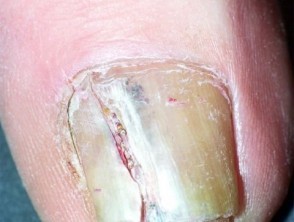Bruise, or Nail Melanoma?
You’ve probably heard of melanoma. But have you heard of subungual melanoma, otherwise known as nail melanoma? Nail melanoma is relatively rare compared to other skin cancers, but it can be serious.
What nail melanoma looks like
Subungual melanoma usually shows up as a black or brown streak or stripe in the nail, and typically only affects one nail at a time (if you see it on more than one nail, though, don’t immediately assume it’s not melanoma). The stripe may be obvious, or it may be faint. Here are some examples:


Other signs
Other things to look for:
- Skin that is darkening or darker next to the nail
- Nail that bleeds or develops a ‘bump’ or raised area
- A nail that raises or comes away from the nail bed without any injury or trauma to that nail
- A nail that splits open
The problem is, subungual melanoma may sometimes be mistaken for a bruise. It does not heal, however, or go away. As your nail grows, the melanoma does not ‘grow out’ of the nail. It is most often on the thumb or index finger or big toe, but can be on any finger or toe.
Don't ignore it!
If you see something suspicious on your nail, what you don’t want to do is cover it up with nail polish and ignore it thinking that out of sight, out of mind. Speaking of nail polish, if you’re one who likes to have your nails polished at all times, be sure to check your nails when they are polish-free during your manicure and pedicure for any brown or black lines, marks or streaks or anything that looks abnormal or unusual.
Your dermatologist may or may not request that you have polish-free nails during your regular checkups. If your doctor doesn’t request this, it’s up to you to make sure you do a close, regular examination of your nails.
Not caused by the sun
Nail melanoma is not caused by sun exposure. The American Academy of Dermatology states that the two main risk factors for nail melanoma are previous nail trauma and a personal family history of melanoma. The incidence rate is higher in older individuals and in Asian and darker-skinned people, although it can affect anyone.
Early-stage subungual melanoma is typically painless. People may unfortunately be less likely to notice it or to be concerned about if it they do notice something abnormal on their nail. According to the New England Journal of Medicine, the outlook for subungual can be poor because there is often a delay in diagnosis.
Be diligent but don't worry
Not every streak or bruise on your nail is melanoma, but if you notice an area on your fingernail or toenail that does not go away within a few weeks, it’s time to see your dermatologist. To correctly diagnose subungual melanoma, your doctor will most likely do a punch biopsy. Subungual melanoma can spread to other parts of the body if left untreated, so early detection and treatment are necessary.

Join the conversation